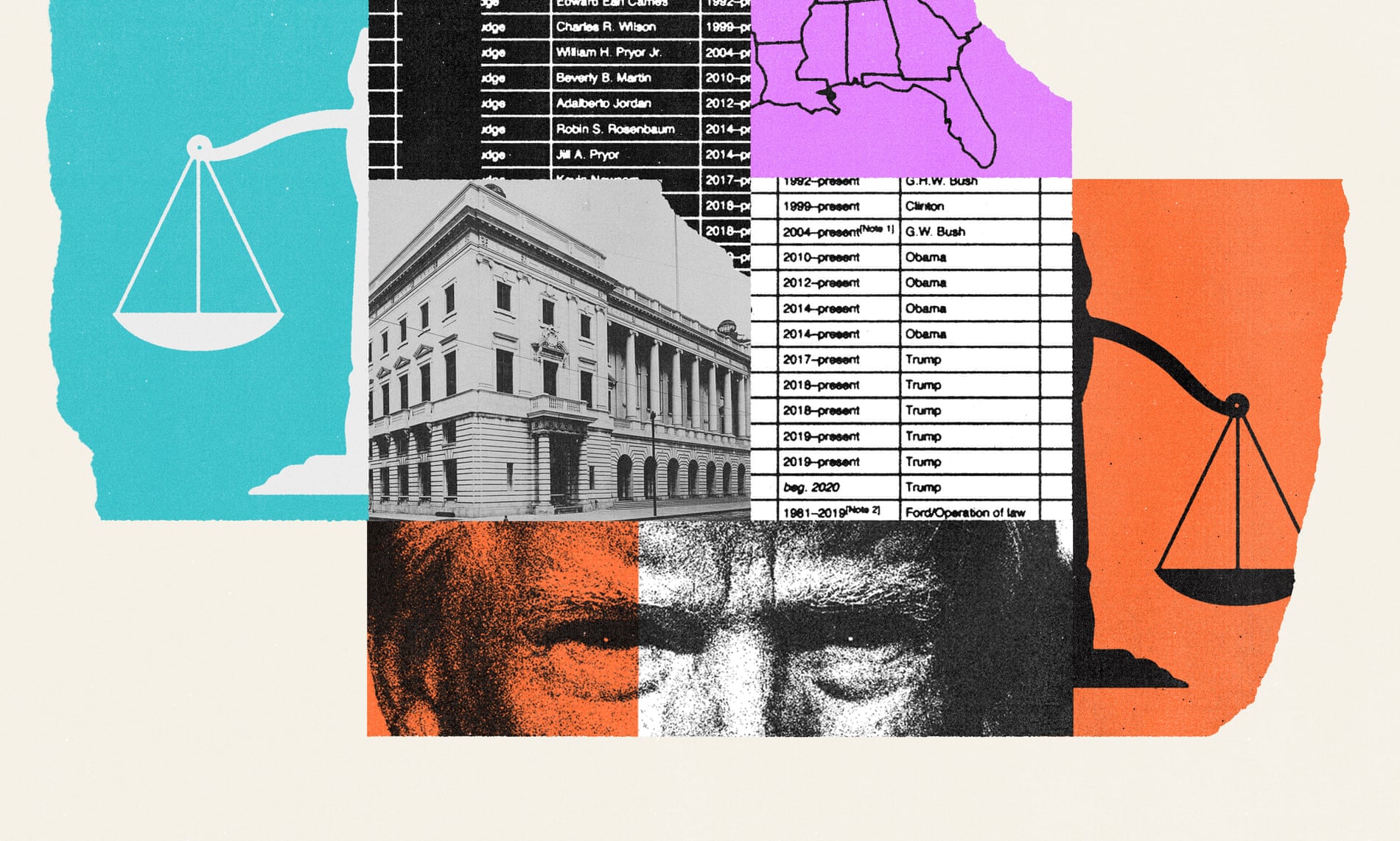by TOM McCARTHY

The president’s judicial appointments have been a quieter project than most of his flamboyant presidency, but will have longer-lasting impacts on healthcare, voting rights, criminal justice and the climate
For all the extravagant projects of the Donald Trump presidency, and for all its flamboyance and bluster, his makeover of the judiciary – a quieter project that has been ratcheted forward by a network of quieter people – may prove to have the longest and most far-reaching impacts on the daily lives of Americans.
All new presidents change the courts by filling vacancies. But what is only now coming into focus is the impact that Trump’s unprecedented number of judicial appointments is having on the courts, ruling by ruling, and on the day-to-day lives of Americans, in areas such as healthcare, voting rights, criminal justice, anti-discrimination efforts and the climate.
“The change is happening. It’s happening before our very eyes,” said Sheldon Goldman, a professor of political science at the University of Massachusetts at Amherst who focuses on the federal bench.
While the US supreme court is the country’s highest judicial authority and attracts most national and international attention, it is the country’s appeals courts that have the last word on justice in the vast majority of cases. They hear thousands of cases each year, compared with the 100-150 the supreme court typically hears. And largely unlike the British court system, federal judges in the United States are selected by politicians in a process that has become an intense area of focus for outside partisans.
Trump has notched more confirmations of appeals court judges, faster, than any president at a similar stage in history, a record he frequently gloats about and cannot resist inflating.
Trump has appointed 51 out of the 179 active circuit court judges, or almost 30% of the entire bench, and next month the total is expected to hit 53. By comparison, Barack Obama appointed 55 circuit court judges and George W Bush appointed 62 – in eight years each. Trump’s judges, who can serve for life, have a starting median age of 48.2, compared with 52.8 for Obama and 51 for Bush. As the country demographically becomes more diverse, they are predominantly male and white, and ideologically they tend to inhabit deep right field.
Together, they are changing America.
My motto for the year is leave no vacancy behind. The pandemic will not prevent us from achieving that goal. Mitch McConnell, Senate majority leader
The Trump administration has come under fire for its dithering and denial in the face of the coronavirus pandemic since the first fatal case outside China was recorded on 2 February. But the White House has been a hive of focused activity when it comes to advancing judicial appointments.
Keeping up a brisk clip established early in his presidency, Trump has advanced 19 judges to fill federal vacancies since early February, in unwavering pursuit of his grand project to impose a new, conservative cast on American justice.
And even as the virus rages, the Senate majority leader, Mitch McConnell, has vowed to make confirming the judges the first order of business when the chamber reconvenes early next month.
“My motto for the year is leave no vacancy behind,” McConnell said in a radio interview on Wednesday. “That hasn’t changed. The pandemic will not prevent us from achieving that goal.”
The Guardian reviewed dozens of cases affected by Trump’s judges, which included creating majorities in rulings that targeted immigrants and workers and undermined protections for society’s most vulnerable. They have:
- Attacked the Affordable Care Act and chipped away at healthcare.
- Greenlighted funding for Trump’s border wall.
- Stepped aside to allow partisan gerrymandering.
- Defended abusive policing.
- Permitted encroachments on the Americans with Disabilities Act.
- Shrugged at emergency requests in death penalty cases.
- Established and reinforced religious exemptions from anti-bias laws.
“We had fears about what these jurists would do when they got on the bench, just from their records,” said Marge Baker, executive vice-president of People for the American Way (PFAW), which has just unveiled a report called Shredding the Social Safety Net on “the Republican plot to use federal courts to destroy public health”.
“This administration more than any has really been putting movement ideologues on the bench who have an agenda. And once we got far enough into the administration, we realized that the judges about whom we had fears were issuing decisions that were highly problematic.”
As shocking as the ruling might have been, scholars saw in it ‘a precursor for what we’re likely to see in the future’ Carl Tobias, a professor at Richmond School of Law
A clear example of the impact of Trump’s judicial project was seen last spring, when the Trump administration stepped up its war on reproductive rights with new regulations gagging healthcare providers from fully counseling millions of mostly low-income women about their options while pregnant.
The new rules threatened to shutter Planned Parenthood clinics and other facilities that offer abortion services alongside healthcare subsidized by federal funds.
As with Trump’s original travel ban, the family planning regulations seemed clearly illegal, with a decades-old reef of legislation protecting healthcare funding from just such attacks by conservative activists.
Three western states immediately sued, and before long a trio of district courts had issued injunctions suspending the new Trump rules. The cases landed on appeal as a package last summer before the ninth circuit court, one of the 13 federal appeals courts, a step below the US supreme court, which are the last stop for justice in almost every case.
The Guardian for more